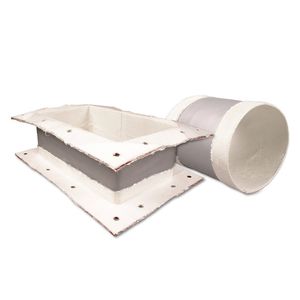
- Hydraulics - Pneumatics
- Pipe, Tube and Fitting
- Rubber expansion joint
- Tubes International
Rubber expansion joint T - EPDMroundflangeaxial
Add to favorites
Compare this product
Characteristics
- Material
- rubber
- Configuration
- round
- Installation system
- flange
- Expansion axis
- axial
- Applications
- for chemicals, for LPG, for petroleum products, for water, petroleum, sanitary
- Nominal diameter
Min.: 32 mm
(1.26 in)Max.: 600 mm
(23.62 in)- Operating temperature
Min.: 0 °C
(32 °F)Max.: 100 °C
(212 °F)- Length
Min.: 95 mm
(3.74 in)Max.: 250 mm
(9.84 in)- Pressure
10 bar, 16 bar
(145 psi, 232.1 psi)
Description
Rubber compensators are widely applied in a variety of industrial pipelines, in power plants, in heating networks (heat transfer stations) and sanitary installations (sewage treatment plants and pumping stations, water treatment stations and machines). Basically, they are mounted near components that produce vibrations (pumps, engines, turbines, compressors etc.). They absorb different movements: axial, lateral and angular that result from thermal expansion of the pipelines or misalignment. They dampen vibration and noise and absorb the energy of pressure variations.
Made of rubber bellow reinforced with synthetic or steel cord and elements that allow connection to the pipeline (usually steel flanges). The compensators are classified according to the bellow material into several types:
compensators made of EPDM, CR, IIR rubber are designed for cold and hot water (industrial water, seawater, potable water), acids, bases and other slightly aggressive chemicals. They are not suitable for oils, fats and hydrocarbons;
anti-vibration EPDM connectors with threaded connections for water installations;
compensators made of NBR or HNBR rubber designed for oils, substances with fat content, petroleum products, some hydrocarbons, natural gas;
compensators made of white NBR rubber intended for foodstuffs, containing fats and oils, or for alcohol;
compensators made of conductive NBR rubber for LPG (butane/propane);
compensators made of CSM rubber for chemical substances and natural gas;
compensators made of FPM fluoro rubber (Viton) for chemicals and hot petroleum products;
VIDEO
Catalogs
No catalogs are available for this product.
See all of Tubes International‘s catalogsRelated Searches
- Fitting
- Piping
- Hydraulic oil fitting
- Screw-in fitting
- Pneumatic fitting
- Metal fitting
- Polymer hose
- Quick coupling
- Nickel-plated brass fitting
- Angle fitting
- Stainless steel fitting
- Tapped fitting
- Structure hose
- Flexible flexible piping
- Elastomer hose
- Polymer fitting
- Abrasion-resistant hose
- Water flexible piping
- T type fitting
- Male fitting
*Prices are pre-tax. They exclude delivery charges and customs duties and do not include additional charges for installation or activation options. Prices are indicative only and may vary by country, with changes to the cost of raw materials and exchange rates.





